The sunken city san pedro ocean remnants
“Sunken City” is the name of a beach along the San Pedro cliffs that holds the remains of a natural landslide that occurred in 1929. The development of homes and exclusive bungalows was established in the 1920s by a man named George Peck to attract people who wanted to live with a beautiful cliffside view of the Pacific Ocean (6). The land around the surrounding area called Point Fermin started to move in 1929, and continuously moved little by little until the slide that made Sunken City (6). The landslide occurred at the southern tip of San Pedro where a piece of land nearly 40,000 square feet in size started sliding away from the cliffs and into the ocean (1). Experts investigating the landslide said that the ground was shifting at a rate of 11 inches per day (1). On January 2, 1929, a waterline broke underneath the Ocean View Inn hotel on Paseo Del Mar, and a few days later a gas line broke under the same building (6). These were the first reports of damage as the landslide began to creep up on the neighborhood of Paseo Del Mar (6). Most of the houses on the 600 block of Paseo Del Mar were evacuated and relocated before the collapse (1). Most of the bungalows were moved, but there was not enough time to move two houses which slid into the ocean (5). Part of the adjoining Point Fermin Park also fell into the ocean (3). The slide displaced 10.5 acres of land filled with houses and other buildings, streets, and sidewalks (6). Martin Scorsese has been a vocal advocate for opening the beach up to the public.
Contents
- The sunken city san pedro ocean remnants
- The sunken city of dwarka
- Geographical Factors
- Social Media Presence
- Proposal for Public Access
- Past Proposal for Public Access
- Public useadvocacy
- Surrounding Attractions
- Incident Reports
- References
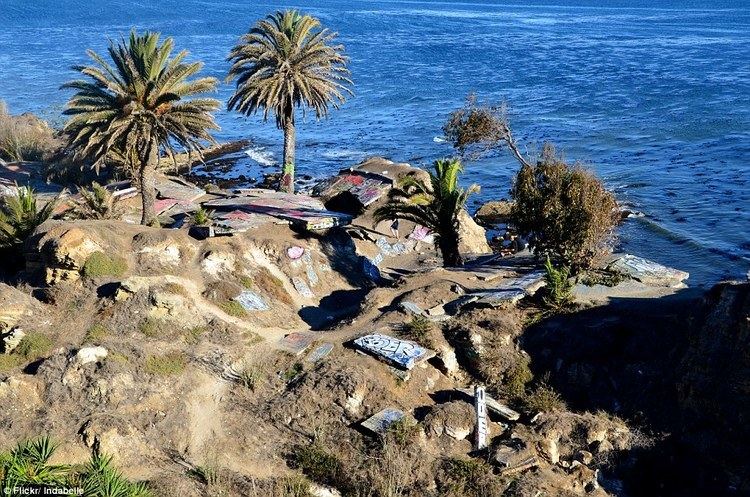
The sunken city of dwarka
Geographical Factors
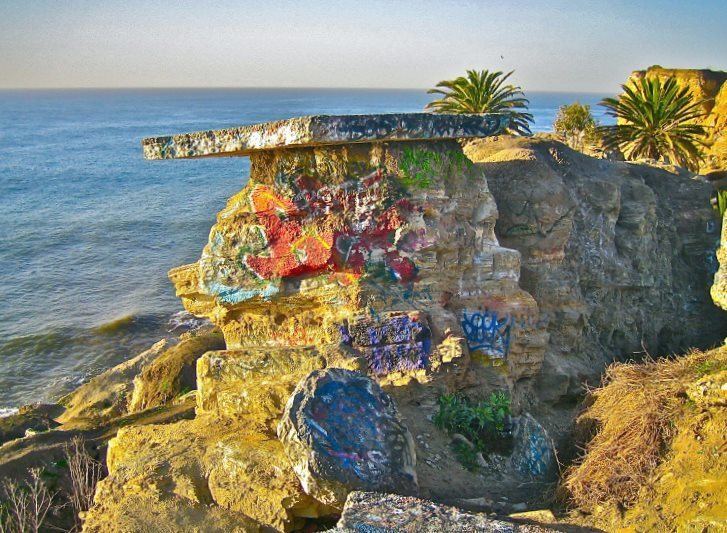
On May 18, 1929 the Los Angeles Times reported the first geographical information about the occurring landslide. The news reported that a crack in the land ran from Point Fermin’s inland sea cliffs for one-half of a block to the corner of Pacific Avenue and Paseo Del Mar (6). The crack in the land had taken in five acres and caused severe breakages in gas and waterlines throughout the neighborhood (6). The undercut of waves from the cliffs caused water to seep into the bentonite layer and cause it to become so heavy that it began moving into the ocean (6). Bentonite is a form of absorbent clay formed by the breakdown of volcanic ash that can be used especially for fillers (6). On the day of the initial slide, the Los Angeles Times reported a crack that caved in in the front of a person’s house that resulted in a deep hole ten feet long and three feet across (6). In California, landslides are common due to its tectonically active environment (6). Some geologists have identified the name for landslides that push land into the ocean as a “slump.” Landslides tend to be more common in places where rocks are weak and slopes are steep, which is how most of the coastal areas in Southern California are structured (6). The Paseo Del Mar neighborhood was a perfect example of this geographical issue. After the landslide disaster, geologists looked into the Fermin Point land structure and found very little record of geotechnical inspection or investigation (6). There were also no geologic or soil reports regarding instabilities within the site, which means that no proper research was done to determine whether or not it was safe to build a community on the grounds (6). The steep cliffs and loose rocks are the reason that the Sunken City beach is fenced off from the public (6). The geographical construction of the land makes it unsafe and potentially hazardous to people’s safety, even if people are experienced in hiking or other outdoor activities (6).
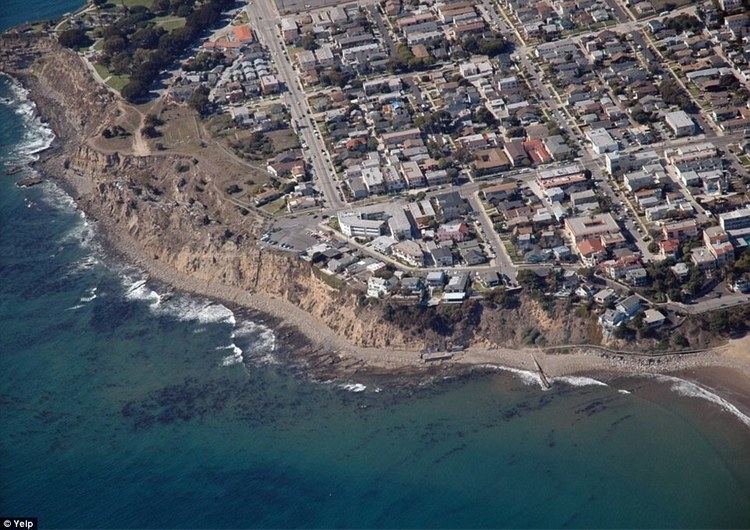
Another aspect about the area that makes it unsafe is that the land is continuing to move, although not as drastically as the 1929 landslide (6). There have been multiple landslides around the area that have caused major cracking in highways within the past several years (6). In 2011, a roadway crumbled into pieces that fell into gaping holes near the White Point Nature Preserve in San Pedro, and part of it descended into the ocean (6). In Rancho Palos Verdes, an area about four miles up the coast from Sunken City beach, an estimated $500,000 is spent in landslide damage repairs per year because the land is constantly moving and slipping into the sea (6). The City of Los Angeles’s engineers and political representatives are conflicting with solution ideas to either spend public money to replace the roadway that was Sunken City, or to leave it as a memorial of the disaster (6). Although, still to this day the City of Los Angeles must spend hundreds of thousands of dollars to repair the damage caused by ongoing landslides (6). Since the landslide in 1929, Sunken City has gone into relative obscurity and is, for the most part, abandoned as far as refurbishment. Sunken City’s street address is located at 500 W Paseo Del Mar, San Pedro, CA 90731 (4).
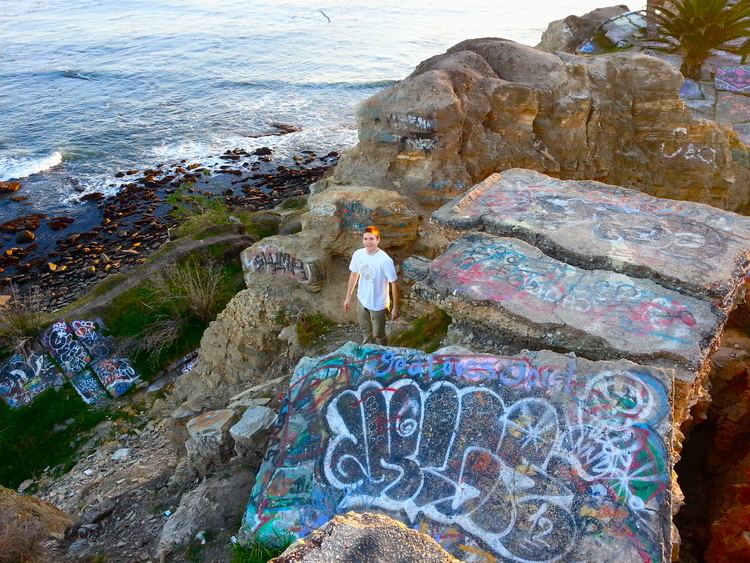
The area is fenced off and is technically not open to the public today. A large “No Trespassing” sign was placed around the beach in 1987 due to a string of deaths and injuries that occurred at the location (2). There have been at least eighteen deaths in the last five years at or near the cliffs of San Pedro or Sunken City itself (7). In 2003, there were five cliffside deaths, two of which happened within a three-day span (7). In 2006, four people fell or threw themselves from the edges of the cliffs onto the rocks below and died along the cliffs of San Pedro (7). In January 2007,a man on the USC football team fell at least 100 feet over the cliffs to his death in San Pedro (7). In the same year, a nineteen-year-old girl simply lost her footing on unstable rocks and plunged at least 50 feet to her death at Sunken City (7). Three more people died in the same year from falls from the cliffs (7). Aside from deaths at Sunken City or areas near it, there have been a number of injuries that have resulted from trespassing past the gate and hiking the area as well (8). People have broken bones from falling, sprained ankles from loose footing, or suffered serious head injuries that caused them to be hospitalized (8). This is the reason Sunken City has been held back from public opening (8). Sunken City is one of the only areas along the coastline of San Pedro that still remains closed to the public (2). However, it is a hidden tourist attraction because of the abundance of graffiti it is decorated with. Sunken City has a beautiful view of the Pacific ocean and also the remains of concrete foundations, curbsides, sanitation, and piping from the neighborhood that once thrived on the San Pedro cliff (1). The beach also offers views of Catalina Island and the cranes of Los Angeles’s port (2). It has gained a sort of cult status due to its whimsical views of graffiti messages from teenagers who trespass the area (2). The beach is closed to the public due to possible safety hazards but it can be accessed through a small hole in the fence that separates the public from the hiking trail that leads to the attraction (1). It can also be accessed by climbing the fence, but it is suggested that one use extreme caution.
Social Media Presence

Sunken City has become a popular attraction for anyone looking for a hiking adventure with a view as the years have gone on. As the word about Sunken City spreads, the beach has begun to gain a presence on social media and other online websites. People have started to share their knowledge and experiences of Sunken City beach, giving advice, directions, suggested supplies, and more to the world through an online platform. Sunken City beach has its own Facebook page where people form a sort of community of fans (9). The Facebook has photos, information, maps, and videos of the beach all posted by people who have been to Sunken City and enjoyed their experiences there (9). The “sunkencity” hashtag on Instagram has over 19,000 tags (10). There was even a movie titled “Sunken City” produced in the year 2012 about a San Pedro cop who is assigned an investigation at Sunken City after a woman’s dead body washes ashore (11). Moreover, the Sunken City was also used and featured in the season finale of the well-known spinoff series of Fear The Walking Dead (12). Many of the fans of the show recognized the famous area and began expressing their excitement by tweeting about it on the social network site called Twitter (12). Sunken City has made it on multiple websites such as Yelp, AtlasObscura, Alltrails, and multiple blogs and sites with guides for places to go hiking and sight-seeing in Los Angeles. Many places around the area in San Pedro have named their businesses after the beach because it has become less hidden and more known over the years. Such places include tattoo shops, skateboarding brands, brewing companies, and more. In May 2015, fans of the off-limits beach conducted an online petition asking for the public opening of Sunken City. The petitioners asked for the opening of the beach during daylight hours and policed by night with lighting, cameras, and ticketing to try to maintain safety. Although access to Sunken City remains illegal and hidden from the public, fans have brought it to life with their presence from social media just as much as the urban art it is decorated with.
Proposal for Public Access
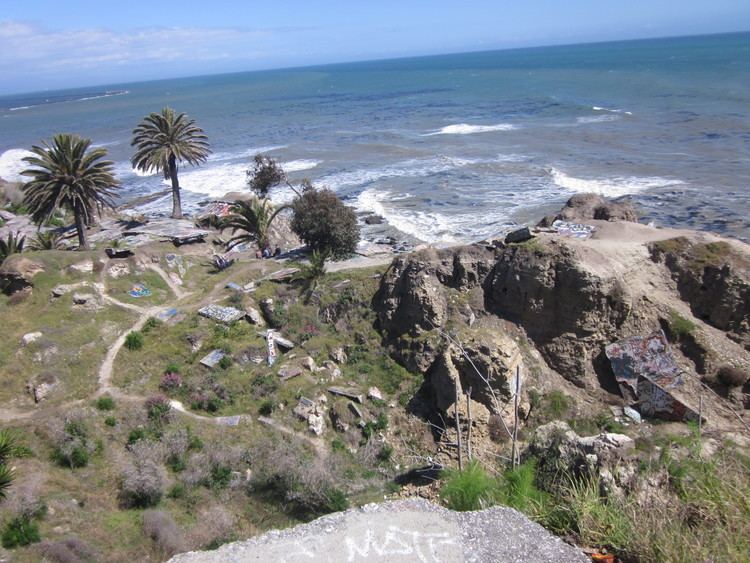
The Sunken City, which is an abandoned development of beach bungalows in San Pedro, southern Los Angeles has been the main topic of discussion in recent years. It is a region that is located exactly on the edge of San Pedro’s coast. While the area is fenced off from the public and has “no trespassing” signs posted up, many still enter the restricted area at their own risk either by crawling through the many holes that has been dug up underneath the fence or by climbing over the fence directly (14). Because of this, San Pedro’s city Councilman Joe Buscaino, has put forward a proposition in opening up the area for the public to enjoy without the risk of being fined by the police The proposition would allow for the Sunken City to be open during the day and would also allow people to be able to walk around the broken chunks of concrete that used to be the streets of the area (14). Buscaino’s proposal would involve keeping the large wrought iron fence up, however, the proposal would require the park officials of the area to install a gateway in the fence that would mechanically close and bar off the area at sunset.
The thought process behind Councilman Buscaino’s proposition is that compared to many other coastline areas, the Sunken City has been one of the only coastal areas that has continued to be restricted for public access (14). Because Buscaino’s idea of the proposition would allow the public to enter the area freely, the city must now focus on balancing the pros and cons in opening up the coastal area, as their main concern is the possibility of there being potential liabilities in injuries that could occur due to curious nature of many of the locals as well as tourists (14). While Buscaino has had a large voice on the subject, there is no set timeline for when such a proposal would or could be initiated (14). Furthermore, even though Buscaino’s plan of proposal would keep the fence up, many argue that the fence serves no purpose, as they claim that people who have an interest in exploring the area either crawl under the fence or simply walk down the cliff-side of the area so that they can swing around the end of the fence and gain access to the other side (14). The proposal to open up the historic area has garnered much attention, as it has many chiming in on the issue. Andrew Willis, the enforcement supervisor for the California Coastal Commission weighed in on the topic and explained that it is fundamentally up to the city of Los Angeles to initiate the proposal in making the Sunken City public for recreational access but that liability is always a topic of discussion that the city government struggles with (14).
Past Proposal for Public Access
Overall, the proposal in opening the Sunken City up to the public is not a new idea (15). In 1989 there was a plan to open up the surrounding area so that the community could have regulated recreational access with a developed nature trail (15). This plan was supposed to be enacted with the installment of the wrought iron fence that now restricts the area. The plan was proposed by then-City Councilwoman Joan Milke Flores, however, the planners that were in charge of blueprinting the design for adding the gates to the fence, so it could eventually become a controlled entry to the site was never put into place (15). In addition, the original plans to open the Sunken City up for public recreational access had seemed to have been lost and forgotten, but with the new proposal being presented by Joe Buscaino, the Coastal Commission has begun to search for the initial plan of proposal (15).
Public use/advocacy
The Sunken City has largely become an attractive site to that of the general residents of the area. Not only that, it has also become so well known that it has caught the interest of many tourists as well. Much so that people from far away as Europe have come to catch a glimpse of the now thought to be apocalyptic graveyard of a San Pedro neighborhood (16). The Sunken City has become so popular in fact, that many of the residents of the Point Fermin area have demanded that the Los Angeles Department of Recreation and Parks to open the area, claiming that the Sunken City area has been stable for plenty of years now (16). Even the head of the Sunken City Watch group has advocated for the area to be opened up to the public (16). Advocates have even sought out legal opinion from the Hermosa Beach law firm of Chatten-Brown & Carstens LLP and they have deduced that in opening up the Sunken City area to the public, the city would face little to no liability at all (16). As it stands now, while many do visit the area, it is essentially illegal and if caught trespassing, violators can face a hefty fine of up to a $1000 (16).
Surrounding Attractions
While the Sunken city is one of the main attractions of the coastal area, nearby are other historic areas that also draw the public in. With a short walk from the west area of the Sunken City is Point Fermin Park, which hosts a large space of green meadows that leads to the Point Fermin Lighthouse (17). In addition, just north of the park is the Korean Friendship Bell, which was donated from Korea to the United States in 1976 (17). The view that the Sunken City has to offer is mainly what attracts and brings many people to visit the area regardless of the “no trespassing” signs and the large fence that is meant to deter the public from exploring. The Sunken City offers many visual sights to enjoy, as you can find tide pools that are filled with purple urchins inhabiting the area and even seals that may be sun bathing (2). In addition, the Sunken City presents the scenic view of the Pacific Ocean as well as Catalina Island, where people can also spot ships sailing along the coast of Los Angeles’s port (2).
Incident Reports
While the Sunken City has had a long history of being fenced off from public recreational access, it has also had a number of incidents occur both criminal and noncriminal. In 1986, there were various complaints and reports filed from the residents that lived within the surrounding area. They reported teenagers sneaking into the restricted area and partying until dawn. The residents also reported to the police during that time that gang members would trespass within the area and hang out there while making loud noises and engaging in both vandalism and theft, as one neighbor reported that a large section of his white picket wooden fence was torn off and assumed to have been used as fuel for a bonfire. Another neighbor expressed her concerns, saying that the noise levels had become so loud for her husband and herself that they had to move from their upstairs bedroom facing towards the Sunken City to their downstairs bedroom which is less prone to the noise because it faces away from the area.
In addition to the problems of trespassing, disturbing the residents, vandalism, and theft within the area of the Sunken City, there have also been incidents where people have been seriously injured as well. In 1982, a teenager fell from the cliffs of the Sunken City while trying to escape from the police who were scouting out and rounding up trespassers within the area that night. This incident led to the replacement of the chain-linked fence barring off the area of the Sunken City with the now wrought iron fence that was installed in 1987. The expense of new fence that was installed was almost over $200,000 and it was thought that it would finally solve the recent problems of the area. However, many more recent incidents have occurred even with the sturdier fence in place. In 2013, a woman was found dead by the Sunken City area and within that same year a little girl who was of ten years of age fell off of the cliffs at Sunken City when she and her mother had snuck past the restricted and fenced off area (20). The girl had suffered considerable head injuries from the fall. Even more recent, in July 2015, a woman fell 20 feet from one of the cliffs in the surrounding area of the Sunken City and had to be rescued by firefighters and paramedics. She was rushed to the Harbor General Hospital in Torrance with injuries sustained to both her arm and leg.
